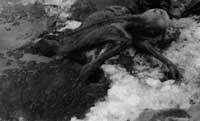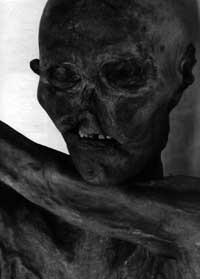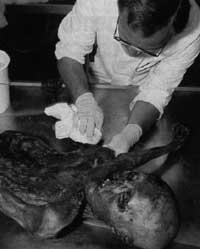Forest found in ice
On a glacier in the Lower Tyrol, they have discovered a man who has spent about 5,000 years in his lasting ice. According to experts, the corpse is of a young man. 1.58 m tall, about 40 kilos and about 30 years. In September 1991 it was discovered by some German tourists. Since then, more than a hundred specialists (doctors, anthropologists, biologists, prehistoric, etc.) work in the autopsy of the corpse.
The story began when two Nuremberg mountaineers were on the Similaun glacier of the Upper Addagio (Austro-Italian border). Descending a path unmarked, they ran into a large block of ice. In it was observed a kind of ragdoll, with the head and shoulders out of the ice. It is believed that he would be one of those mountaineers who have appeared every year on glaciers. He was called “otzi” or “hibernatus”.

The corpse is currently in the Innsbruck Institute (Austria), in a cooling cell at a temperature of 6ºC and 98% humidity. Some sensors monitor compliance with these requirements at all times. And if they are not filled, fungi, bacteria and insects would destroy the body.
But before the body reaches the place it has suffered a series of vicissitudes. Once the body was located, the police officers of Schnalza (Italian province of Boltzano) and the gendarmes of the Austrian village of Soldau were notified. The Italians entrusted the responsibility of discovery to the Austrians.
There would begin a succession of facts and errors. From Thursday until the following Monday, the middle body came out of the ice and was left without any protection and guard; any animal could attack him. The pneumatic hammer was then used to exit it. Undoubtedly, the most inadequate instrument for use in the operation that required great importance. Various leather tools around the body, knife, metal axe, etc. were found and piolets were used to remove them. This made many experts very angry. But in favor of these seekers it must be said that still no one thought that he could be the man of the Neolithic.
Finally, next Wednesday, the University of Innsbruck took on post-discovery work. He was taken by helicopter and began to examine the body.
Where did they find it?
It is not clear where they found the body. When the Italian police officers were ordered to carry their bodies, they refused claiming that they were in Austrian lands. Because the border is in that area. To find out in which area of the border Otzi was found, the Italian and Austrian government had to call topographers.
Surveyors defined the boundary by drawing a straight line between two points. According to this, Otzi was an Austrian citizen. But at the last moment they marked the third point between the previous two and it was proved that the limit was defined by a triangle. According to this, the body was in Italy.

The manipulation hypothesis has also been extended. Doubts about whether the body was moved from one place to another are reaffirmed with the following arguments: the Austrians wanted the body to be Italian. Otzi's discoverers were Germans and if they exercised their rights before the Austrian government, Austria should comply with international law and, if any, share royaltis with them. In Italy, however, a decree of 1938 in force, which says that any finding on Italian soil is a national historical treasure, so it remains out of any distribution.
Otzi in the end is from Italy. They have left the Austrians to study it and will return to a museum in Bolzano.
When is Otzi?
The stranger of Similaun has a very ancient origin. Four laboratories have dated body samples and objects. According to them, the corpse is about 5,000 years old. It is therefore believed that at the end of the Stone Age, at the beginning of the Neolithic, it was probably lived in the Eneolithic or Calcolytic during the transition of the Metal Age.
In the objects found around the mummy you can see some surprising things. After analyzing the axe, the end of the Neolithic has been considered close. Copper leaf inserted into the wooden handle.
This discovery has surprised researchers. It is very surprising that a Stone Age man uses an axe like the axe he began to use in Europe 1,000 or 2,000 years later. The age of the unknown and the dates of use of copper do not therefore coincide.
Otzi carries a small handful. It could be the tip of the arrow. Although this piece is in poor condition, it is fever and may date. The method of thermoluminescence used in pottery is a suitable method for the study of fever. In any case, it will be difficult to use this fever as data to check the age of the unknown Similaun, since it may be owned by another owner.

Much more surprising is the rest of the Otzi team. It is not clear with what blades I was going out to the mountain, but I was carrying a very well prepared luggage: lined shoes, like a double layer leather anorak with cold protective plant layer (patches with grass and left-handed), food, bow and buoy with arrows (karkaja) (leather bag reinforced with a golden stick), etc.
We do not know if the shepherd, the hunter, the merchant was a magician; there are all kinds of hypotheses. At that time grazing was traditional in the Alps. He also carried the hunters' ties with him. But there are things that are surprising, like a 1.80 m tooth arch. The ends have no tips or slots to tie the rope. The fourteen arrows do not serve either, only two were available. Why did he carry the bow and the arrows that were not used to cast? With this weapon he would not do much hunting, nor, if he was a shepherd, keep the animals away from the flock. Perhaps because he was a magician who fought symbolically with the spirits. So why did he carry the knife, the axe and the rest of the properly prepared weapons?
Place of preservation of the corpse
The conservation of the corpse (glaciers) also raises some questions. Any glacier can be compared to a river. Some are fast, like the Bossons de Chamonix, which advance between 100 and 150 m each year. Periodically returns the remains of the dead in plane accidents since 1950. Others are slower: In the Innsbruck region, last year seven bodies of soldiers disappeared in the First and Second World War appeared. Theodul Glacier in Switzerland, near Zermatt, exposed a Swiss soldier who had fallen to a canyon and was 400 years old. There is one clear thing, according to glacier experts, there are no glaciers that spend more than six hundred years dragging snow from the top to the glacier tongue.
Otzi spent 5,000 years on the Similau glacier. At that time the permanent snow lands began above 3,300 m. The discovery point is 3,400 m. A body cannot, therefore, remain five thousand years in the glacier that is renewed every six hundred years. It is possible that there is an isolated cuvette, the discovery area is a rocky space in the area of completion of the glacier.
About fifty centuries ago, the glacier then carried blocks of ice and rock off the main road. They passed through the small valley and passed over the bucket where Otzi was. Kubeta kept the man from Similaun for 5,000 years. The strong heating of recent years, the exposure of sand winds from the Sahara in March 1991. This sand on the snow does not reflect the rays of the sun, absorbs and melts the ice of 10 cm thick per day. It would only take six days to reach the 60 cm depth of the body.

The integrity of the body also causes some questions. Many tons of stones fall on a glacier. They absorb the heat from the sun and in an ice cream, like the pieces of chocolate, melt the ice around them, slowly sinking it. They collect huge convection currents and make the plates, the subduction zones, slide over each other by dispersing pebbles. The plate erodes the mountain and reduces everything found. As a result, fragments of corpses have been seen, but not whole remains, since due to the movements of the glacier they are dislocated.
To explain that Otzi has not endured these pressures, we must take up the hypothesis of the ice cube and think that it would isolate it from the ice currents in its surroundings.
Mummification
Mummification also raises questions. It can be thought that Otzi, in the middle of glacier, on ice, slipped and fell unpredictably.
According to experts, very special weather conditions had to be given to reach us as man has arrived. According to hypotheses, it would die in autumn (according to the fruits found together with the corpse can be thought). Then there would be a sudden climate change and the hot wind, the foehn, would dry the body. After winter, the body froze and dehydrated quickly. That is, the body would have been “freeze-dried” (freeze-drying itself is a low-temperature vacuum dehydration). The body was covered by a thick layer of snow and hermetically preserved for thousands of years.
If this process is true, it surprises with homogeneity. When falling face down on the ground, not all parts of the body would be affected in the same way. The armpits, faces and, in general, the points of support would not be affected by the phenomenon. On the other hand, it had to have a very hot, tropical air, so that the body dried very quickly.
The hypothesis of natural mummification by foehn is none other than that. It is true that abandoned victims die to rites and in the Andes, far above, they are mummy shaped. But it is not the case of the mummy of Similaun, whose skin has the form of leather glove placed on the skeleton. Soft parts: crines, muscles, ears and eyes. It is impressive for Egyptologists. In fact, the oldest mummies in Egypt are 3,000 years old and, despite human action, are not so well preserved. In addition to the absence of viscera and brains, all of them were chemically treated during embalming. Similaun's, on the other hand, was naturally mummified and still retains some biological characteristics. Therefore, experts do not know how it has been preserved so well.

Not all agree on the hypothesis that ice, inside the bucket, was the engine of mummification. Normally bodies trapped by ice do not have that appearance. The skin is tanned, the tissues grow, coil and divide. Fettwax removes all tissues and leaves them unrecognizable. The most similar to the glacier man are those of the Franklin expedition. The deceased sailors were buried on an island between Canada and Newfoundland in 1846. They had a skin and a body like the mummified natural ones. However, these sailors were buried in icy, wind-protected lands. Its conservation environment resembles the humans of the Scandinavian Iron Age peatlands, which threw the Danish swamps after ritual death. These are the mummies that preserve this whole, especially that of the epidermis, and that appear in the man of Similaun.
Perhaps Otzi, first mummified, buried himself in the ice. But it cannot be explained why the scavengers did not attack him before burying the corpse in the snow. Vultures, for example, attack the first eyes when they find an animal or a dead man. Otzi didn't have that: his own are not attacked. Only on the back of the skull is a kind of wound that can be a pecking.
Otzi's skin is also surprising. The bag they found around the body was frayed. The surface of the mummy had to withstand the same transformation. Even more uncured. But that hasn't happened to him: it looks like a waterproof tanned leather. What chemical phenomenon has affected human skin so that, unlike the sack, it becomes so rigid and waterproof? If the corpse has undergone a natural mummification process, why hasn't the same thing happened to the bag?
In addition, the mummy situation is strange. When discovered, he was exposed to cold and heat for four or five days. In these cases the skin should have wrinkles and mucous alterations, but it has not been so.
If mummified before burying the pit, there should be remnants of substances used in mummification. Bitumens, asphalts, aromatic plants, etc. used to embalm mummies leave a mark on the tissues. But they were not analyzed. It was introduced in the otzi phenols for better conservation.
There are many more curiosities. For example, the strong wear of the teeth before humans does not correspond to age.
Is he a magician?

When they found her the penis was missing. They don't know if they died before or were removed from the ice. Otzi can be magician and rite.
The body has several tattoos: three sets of vertical lines on the skin of the back, cross on the left knee and pairs on the right ankle. Surely they are made of charcoal and had some magical mystical meaning to protect themselves from evil spirits. Among his things was a stone disc with a leather lits hung from a small hole. You might think he was a favorite.
There are still many doubts about this issue. Scientists doing the autopsy try to find out. Each of them will investigate a fragment of corpses: blood samples from geneticists to analyze the genetic material and compare it with the following; other pieces of clothing to analyze the contamination of the time; parasitologists will perform bacteriological analogies; others will study a part of the brain, etc. The small fragments of corpses will be dispersed throughout Europe and the rest of the continents for study. Let's see if everyone clarifies something about this man.





